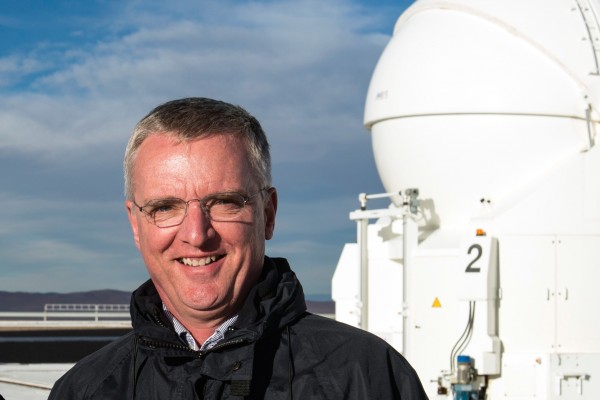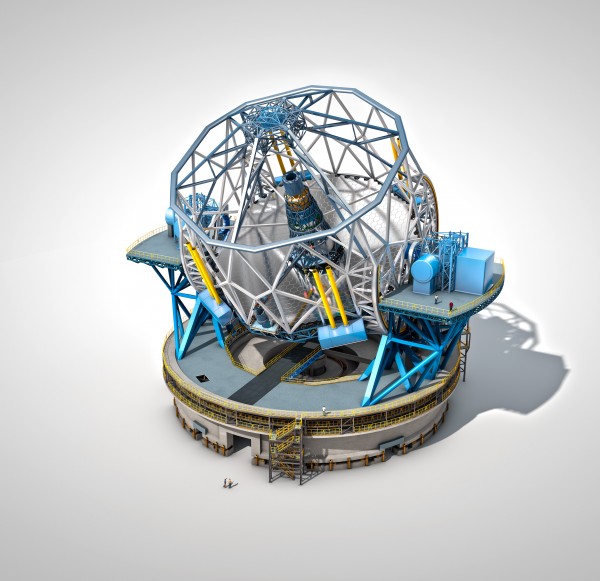“The goal is to enable science”
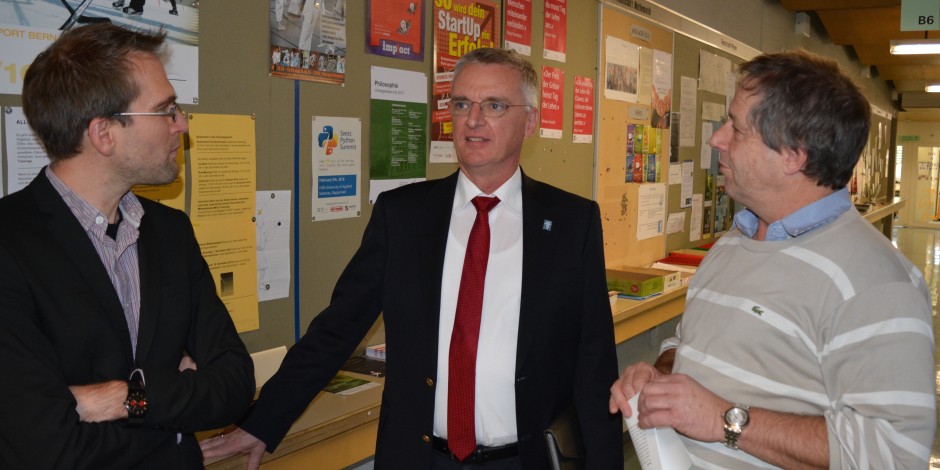
“Building the world’s largest telescopes at ESO” was the title of Tim de Zeeuw’s talk at the University of Bern. “To be able to help science and have the countries work together – that’s something I really enjoy doing”, says the Director General of ESO.
PlanetS: What is the biggest problem building the world’s largest telescopes?
Tim de Zeeuw: I would say it is not a problem, it is a very interesting challenge. Let’s go to ALMA, the radio telescope in northern Chile. This provides a two orders of magnitude increase in power over anything that existed before, because it’s a lot of telescopes, many more than before, it’s the best technology for the receivers at the time, and it’s half way into space. It’s 5000 metres high where there is so little water vapour above you that you open the curtains and actually detect submillimeter radio waves, whereas from here you would only listen to the atmosphere.
Building a telescope at 5000 metres is extremely difficult, technically and humanly. And it is a global partnership because it’s expensive. North America, ESO and East Asia, mostly Japan, decided to team up. You get very interesting differences in culture, for instance a different philosophy about money. But you manage it because there is this common goal.
What is the interesting challenge of the 39-metre E-ELT, the European Extremely Large Telescope, that ESO has started to build on Mount Armazones, about 20 kilometres south of Paranal?
For the ELT, the main mirror has five times the diameter of the biggest mirror that ESO currently has. That means that the images can be five times sharper. But then, you have to make sure that the telescope tracks the objects with five times the precision, otherwise you blur the image. The size of structure that needs to do that goes with the cube. That means, it is a tremendous engineering challenge, and we can only do it with computer-aided design.
The construction of the ELT will cost a bit more than one billion Euros. Raising the money for it also took some time. But despite the financial crisis that hit many of the member countries, they increased the ESO budget to be able to build the ELT. I am very happy that I had a hand in this. We are now on track for first light in 2024.
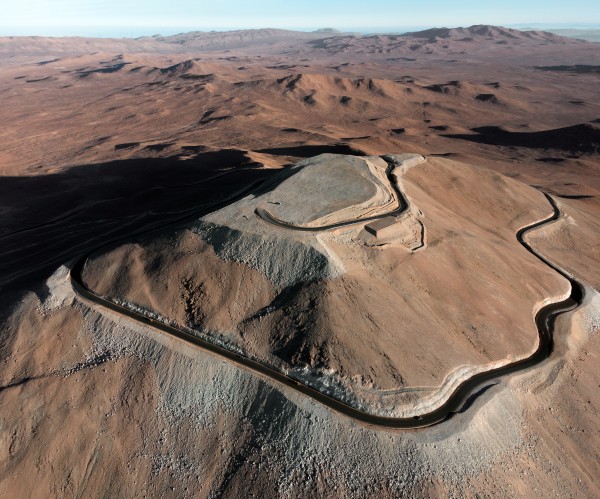
The flattened mountain top of Cerro Armazones will host ESO’s 39-metre European Extremely Large Telescope (E-ELT) (Image: ESO)
Is there a limit in size?
There was a precursor plan at ESO in the late 90s, the OWL or Overwhelmingly Large Telescope with a 100-meter-diameter. The engineers and scientists realized that in principle it is technically possible to build it. But the risks are big and the conclusion was that it was not feasible to raise the funding. I don’t think that we will be thinking about building a 100-metre telescope any time soon. The ELT will be for quite a while the largest optical and near-infrared telescope in the world.
What will be the most important discoveries of the ELT?
It is possible that the ELT will be able to detect the composition of the atmosphere of a planet orbiting another star and it might demonstrate that there is biological activity. I am not saying sentient life. And whether the ELT will be the first to detect it we don’t know, but that is one of the exciting possibilities.
By that time people won’t be surprised because our society has philosophised about planets orbiting other stars for at least 400 years, and all of us have seen plenty of science fiction.
In another project that is intellectually very exiting you could be able to measure directly the expansion of the universe. I simplify: You look at quasars that are far away in the universe. You measure the spectral lines today, and you do it again in ten years. Then all the lines have shifted because in the meantime the universe was expanding. This will be very hard to measure, your instrument has to be ultra stable.
As ESO’s Director General you have to fulfil a lot of management tasks. Are you still able to work as an astrophysicist?
I still have a little time for research. I supervise two graduate students one in Munich, and one in Holland where I now and then still go. And I remain a member of some teams that do research with ESO telescopes. I help the younger people by providing advice and commenting on manuscripts..
Do you miss research?
Less than I thought. I really enjoy the other part of my job. The goal is to enable science and that requires quite a lot of things. There are technical, financial, political and governmental aspects. To be able to help science and have countries work together – that’s something I really enjoy doing. And you meet the most interesting people that you didn’t think you would ever meet – I met James Bond.
Was is when the movie “Quantum of Solace” was filmed at the VLT, ESO’s Very Large Telescope, on Paranal?
Yes, the residence at Paranal was blown up by James Bond. It took him only 8 minutes! But we rebuilt it, of course. In fact, the scenes inside the residence were filmed in London, but the scenes outside were at Paranal. Daniel Craig was very friendly, a bit shy, but impressed when we showed him the telescopes. And at the end, he asked the person in charge of logistics at the reception for some souvenirs of Paranal which of course she gladly gave him.
You welcomed a lot of famous people on Paranal. Do you have a particularly nice memory?
The former president of Chile, Sebastian Piñera, announced “we are coming to your mountain and I will bring colleagues because we will sign an agreement with four countries”. So the presidents of Mexico, Colombia and Peru were standing on the VLT-platform when Piñera had his speech saying: “The four telescopes behind me are independent, but they are much stronger when they are together, that’s what the goal is for our Pacific Alliance.” Later, the king of Spain dropped in. He asked for a cup of coffee and wanted to talk to the four gentlemen. And when we had a scientific meeting the president of Mexico took notes because it turned out that he was an amateur astronomer. There is always something exciting happening on Paranal.
Visiting the University of Bern and the NCCR PlanetS what is your impression?
This kind of initiative where you have several institutions working together to maximize science goals having both instrumentation and theory is the model that has been used in some other ESO member states as well. It makes science move forward and makes that Switzerland gets the best out of its ESO membership.
In Bern, I was very impressed. I had not realized how large the technical infrastructure is in this institute. I was aware of the theoretical studies, but also a lot of the observations are originally done with instruments that have been built here and fly in space. So I think it is a great initiative.
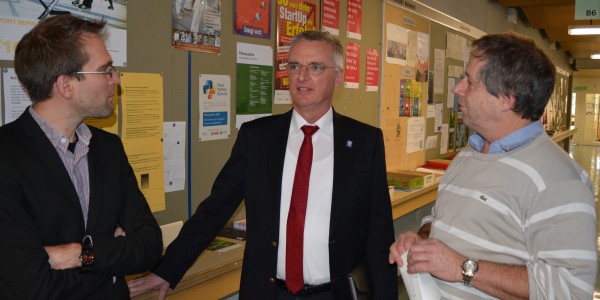
Tim de Zeeuw (middle) with Marc Schumann (left) and Willy Benz (right) at the University of Bern. (Image: PlanetS)
More information about ESO and its Director General, Tim de Zeeuw: www.eso.org
Categories: External Newsletter, News
